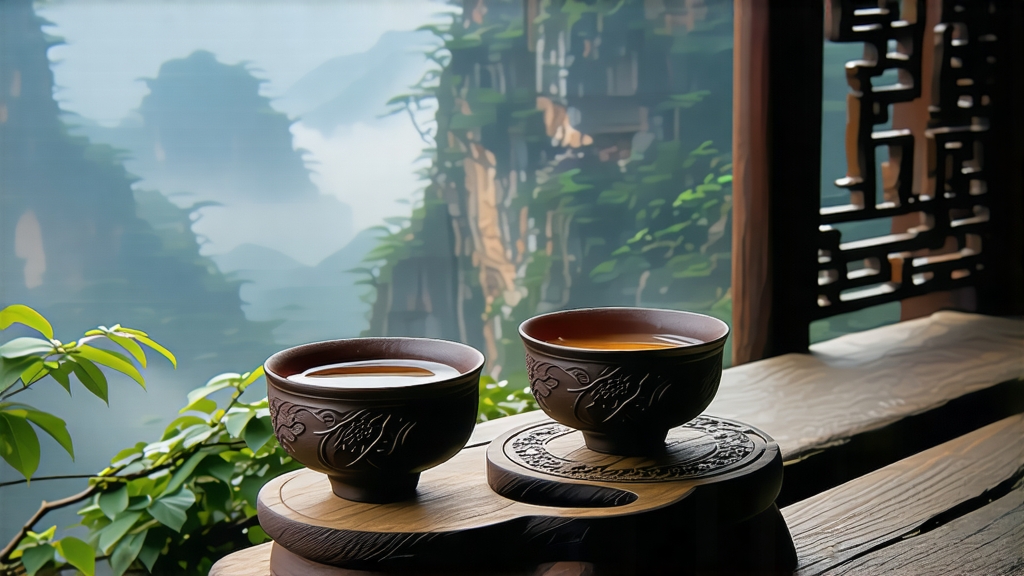
If green tea is China’s springtime and pu-erh its autumn, then Wuyi Shui Xian is the mountain’s midnight conversation between stone and water. Originating in the 1,000-metre-high gorges of northern Fujian’s Wuyi Mountains, this oolong carries the literal taste of its birthplace: minerals leaching from purple-red igneous cliffs, mist that never quite burns off, and a river named Jiuqu (“Nine Bends”) that wraps the peaks like silk ribbon. Locals call the tea “Water Immortal” after a legend in which a drought-stricken village was saved by a celestial maiden who spilled her jar of sweet water; wherever droplets touched the rocks, tea trees sprouted overnight. Whether myth or marketing, the name stuck, and today Shui Xian is the most widely planted cultivar in the Wuyi protected appellation, outnumbering even the more famous Da Hong Pao mother trees.
History
The first written record appears in 1821, when a monk from Tianxin Temple bartered 300 cake-shaped bricks of “Shui Xian” for land rights. By the 1890s, export brokers in Xiamen were shipping it to San Francisco’s Chinatown under the label “Bohea Narcissus,” a fragrant curiosity that survived the trans-Pacific voyage better than green teas. The 1920s saw charcoal-baked versions served in London’s Ritz as “China Rock Tea,” a name that puzzled guests who expected pebbles in the pot. During the 1980s, selective clonal propagation tripled acreage; today, genuine Wuyi Shui Xian must be harvested within the 70 km² core scenic zone, an UNESCO mixed cultural-natural heritage site where picking still follows the lunar calendar: always after Guyu (grain rain) but before Xiaoman (grain full), when leaves have “opened but not yet spoken.”
Cultivar & Garden Ecology
Shui Xian is a large-leaf, medium-late budding variety genetically distinct from the Qi Dan or Bei Dou lines used for Da Hong Pao. Its leaves are ovate, 10–14 cm long, with a waxy cuticle that reflects the intense UV of the cliffs. Growers plant it in narrow strips called “rock nests” (yan wo) where weathered rhyolite has crumbled into gravelly loam. Because the terrain is too steep for tractors, every bush is pruned by hand into a “dome” shape that resists wind and maximizes morning mist exposure. Beneath the canopy, ferns, orchids and even cinnamon trees create a living mulch; their fallen leaves add vanillin and terpenes that later surface in the cup as orchid and spice notes. No synthetic fertilizer is allowed—only bean cake and river-mud compost—so nitrogen levels stay low, concentrating aromatic rather than bitter compounds.
Crafting the Rock Rhyme
The goal is to capture what locals call yan yun—“rock rhyme,” a tactile after-impression of minerality that arrives seconds after swallowing, like the echo of a temple bell. The process unfolds in five acts:
- Picking: three leaves and a bud, 4–6 cm length, carried downhill in bamboo crates lined with banana leaves to prevent bruising.
- Solar withering: spread on rush mats for 20 minutes at 28 °C to reduce moisture to 70 %; the short exposure preserves greenness yet initiates enzymatic honeying.
- Indoor shaking: the “green room” is kept at 24 °C and 78 % humidity. Every hour for the next 12 hours, masters toss the leaves into the air, letting them slap against bamboo racks; edges bruise, triggering partial oxidation while veins remain green. The rhythm is musical: three claps of the hands, one full rotation, rest 59 minutes—repeated until the leaf emits a sharp apple-peel scent.
- Kill-green: a 280 °C drum roaster for 90 seconds halts oxidation at 45 %, the sweet spot between green tea’s grassiness and black tea’s malt.
- Charcoal baking: the signature step. Three layers of wire mesh are stacked above a pit of glowing lychee-wood embers (no flame, only infrared heat). The tea is baked for 6–8 hours, rested 20 days, then rebaked; top grades cycle